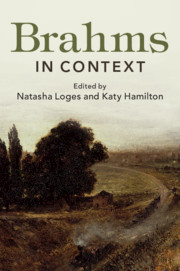Book contents
- Brahms in Context
- Brahms in Context
- Copyright page
- Dedication
- Contents
- Illustrations
- Music Examples
- Notes on Contributors
- Preface
- Abbreviations
- Part I Personality, People and Places
- Chapter 1 Childhood in Hamburg
- Chapter 2 The Schumanns
- Chapter 3 Vienna
- Chapter 4 Leipzig and Berlin
- Chapter 5 Personal Habits
- Chapter 6 Correspondence
- Chapter 7 Holidays
- Part II Identities, Environments and Influences
- Part III Performance and Publishing
- Part IV Society and Culture
- Part V Reception and Legacy
- Further Reading
- Index
- References
Chapter 3 - Vienna
from Part I - Personality, People and Places
Published online by Cambridge University Press: 15 May 2019
- Brahms in Context
- Brahms in Context
- Copyright page
- Dedication
- Contents
- Illustrations
- Music Examples
- Notes on Contributors
- Preface
- Abbreviations
- Part I Personality, People and Places
- Chapter 1 Childhood in Hamburg
- Chapter 2 The Schumanns
- Chapter 3 Vienna
- Chapter 4 Leipzig and Berlin
- Chapter 5 Personal Habits
- Chapter 6 Correspondence
- Chapter 7 Holidays
- Part II Identities, Environments and Influences
- Part III Performance and Publishing
- Part IV Society and Culture
- Part V Reception and Legacy
- Further Reading
- Index
- References
Summary
Brahms arrived in Vienna as an ambitious young musician, settled there in his early thirties and remained for the rest of his life. His flourishing career mirrored the dramatic transformation of the Habsburg Empire and its vibrant capital city during this period. Recent studies about creativity illuminate the historical, geographic and demographic circumstances that converged in late nineteenth-century Vienna to forge its special character. This chapter will explore the city where Brahms spent his most productive and influential decades, highlighting the unique opportunities the city and its intellectual elite provided to stimulate his greatest creative accomplishments.
Long an important crossroads of Europe, Vienna in the last half of the nineteenth century evolved rapidly as an urban metropolis and musical capital. Its population swelled nearly fourfold between 1857 and 1900, largely due to in-migration from farther reaches of the Habsburg Empire.
- Type
- Chapter
- Information
- Brahms in Context , pp. 23 - 32Publisher: Cambridge University PressPrint publication year: 2019

